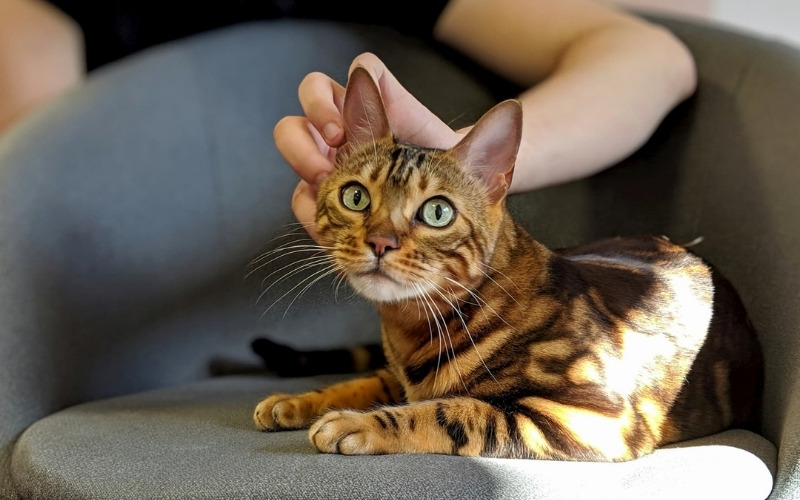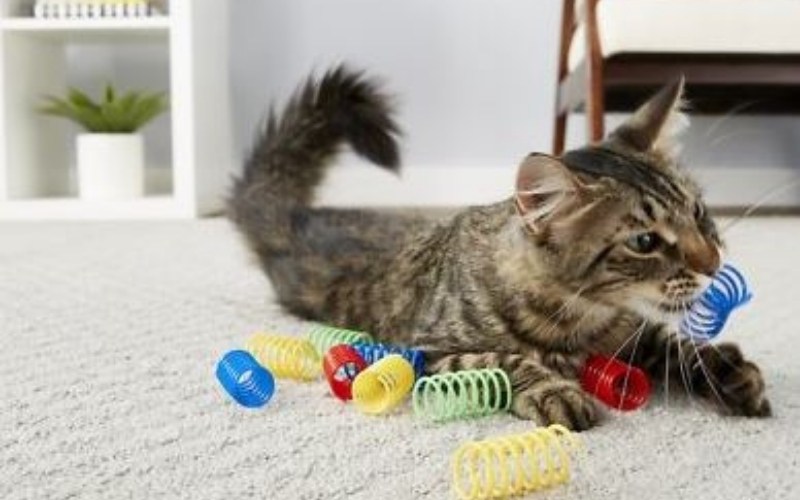Bengal cats are beautiful animals that are also highly intelligent. Both qualities are reasons why people pay a lot of money to own one. One thing many new Bengal cat owners don’t count on is the constant vocalizations.
Bengal cats cry because of the same reasons other domestic cats cry. They want you to do something for them. That’s either food, playtime, stimulation, going outside, or companionship. Many cats, including Bengals, vocalize a lot when they are bored.
Read the article below to answer the question of why your Bengal cat is crying?
Bengal Ancestry Is Silent
The idea that Bengal cats are naturally more vocal than completely domesticated breeds is a myth. The wild Asian leopard side of the cat’s ancestry is primarily silent. That’s because it needs to be quiet to survive in the wild.
As kittens, the mother urged silence to keep predators away. As adults, the leopards had to be quiet to stalk and capture prey. The only vocalizations these animals gave was as babies to their mother to indicate a need for food or warmth.
Breeders and animal experts state the vocalization aspect of the Bengal cat comes from the domesticated side of the breed. The further away a cat is from their Asian leopard ancestor, the more vocal the animal is. Fifth-generation Bengal cats are far more vocal than the first generation.
Each cat is different. Some Bengal cats are more vocal than others and that largely depends on the cat’s personality and the relationship with their human.
Cats tend to vocalize more when they have a strong bond with their human owner.

Read: Are Bengal Cats Stronger Than Maine Coons?
The Bengal’s Voice
One of the reasons the Bengal cat is linked with vocalization is because of the harshness of the breed’s voice. Bengal cats can sound loud and wild when they vocalize. This breed also has a wide vocabulary of sounds which can range from chirping, cooing, a gravelly sound, a growl, and loud meow.
Bengals can put inflection into their voice, which makes them highly communicative. They almost have a human emotional quality to their voice.
The Reason for Vocalization
Bengal cats, in fact, all cats, vocalize to communicate with their humans. That is why the domesticated breeds become more vocal as it isn’t needed in the wild but are highly beneficial as a pet.
The Bengal cat is highly intelligent and quickly picks up on human vocal tones. They copy them in their attempt to communicate in ways humans understand. This is why they sound almost human.
Cats quickly learn that vocalizations get results because their owners respond. Cat owners talk to the cat when they vocalize, give them food, let them out or play with them. This reinforces the idea to the cat that being vocal is a good way to express their needs and get what they want.
Read: Are Bengals Good Travel Cats?
How to Control Vocalizations?

Owners of Bengal cats can control how much their pet vocalizes with some simple strategies. After all, the cat is using their crying to train you to do what they want. You need to change the game to train them when vocalization is appropriate.
Here are some strategies to re-train your Bengal to stop crying.
Feed on a schedule
Stop free-feeding your cat whenever he cries. Another change should be to quit feeding your cat first thing after you get up in the morning. Feeding him right after you get up is instilling the idea in your cat that he can wake you up to get fed.
Instead, have your coffee and breakfast first before feeding your cat.
Read: How Do Bengals Do with Groups of People or Strangers?
Have structured play
One of the key reasons your cat cries is because he’s bored. Make sure to have regular playtimes to wear him out. Failure to play with your Bengal cat will mean they will stay up late at night to get rid of excessive energy.
Bengals are highly energetic and need a lot of activity. This is part of the animal having a wild ancestor. They are particularly keen on hunting and need outdoor fun.
That means you will either need to let your Bengal out to play or learn how to harness train him to take him on walks.

Offer stimulating toys
Toys that challenge your cat’s brain and body will stimulate and entertain him even when you aren’t there. That will eliminate boredom and excessive crying.
Bengal cats love puzzles and there are plenty of those types of cat toys on the market now. Puzzle games are good to leave with your cat when you must leave the home for longer periods.
Use jungle gyms and wheels
Your Bengal cat will love anything that allows him to be active, climb, and play. This includes putting a cat jungle gym stack by a window or installing a cat tree in a taller space. That will allow your cat to perch high where he can observe his kingdom.
Some creative cat owners even put staggered shelving all up a wall so their cat can climb as high as he wants.
Cat owners using a cat wheel say it helps their pets get rid of energy. Wild cats can roam up to five miles and a Bengal has the same need to roam. Yet, roaming outside, especially at night, is dangerous for your cat and other animals that could become prey.
A cat wheel can help your Bengal act out his roaming instinct. It can be used at night without bothering your sleep.
Most pet owners who use a cat wheel say the devices are quiet so they aren’t bothered as their cats use them all night.
Read: Is It Common for Bengal Cats to Be Overweight?
Train the cat
Bengal cats can be trained with treats much the same as dogs and training your cat to do what you want will show him you are in charge.
Start with simple things like offering a treat for sitting or coming when called. Then move on to more complicated things like harness training, or tricks.
Ignore the crying
This is tough to do but must be done to regain your power in the home. You must teach your Bengal that crying will not get him what they want. That means ignoring him while he cries. Wait until he is done crying and then give him a treat when he is quiet.
You can then do what the cat wants like feed him or let him out once he has quietened down and after the treatment. This will show your cat that he will only get what he wants when he is quiet and calm.
Be aware it will take several weeks to completely train your cat to quieten his vocalizations, so you will need to be patient. Be prepared to invest in earplugs if necessary.
Remember, this re-training is a battle of the wills. You will need to be more stubborn than your Bengal cat when it comes to him being quiet.
Read: How to Become a Bengal Cat Breeder?
Conclusion
Bengal cats aren’t so different from other cats in that they just want to communicate their needs with their human families. They sound different from smaller, domestic breeds because of their size and structure. Yet, their motivation for vocalization is the same as all other cats in that they want humans to meet their needs
Understanding that will help you greatly as you retrain your Bengal cat to vocalize less.
